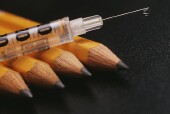
TUESDAY, May 17 (HealthDay News) — The penile foreskin can harbor the human papillomavirus (HPV) responsible for cervical cancer and genital warts, although experts disagree on whether this means that boys as well as girls should get vaccinations designed to prevent later sexual transmission.
In a small Austrian study, nearly a third of the foreskins in males examined contained strains of human papillomavirus (HPV), one of the most common sexually transmitted infections and the cause of 70 percent of cervical cancers. HPV can also lead to genital warts in males and females.
The results were to be presented Tuesday at the annual meeting of the American Urological Association (AUA) in Washington, D.C. Research presented at meetings is considered preliminary until it is published in a peer-reviewed journal.
“To have [HPV] present in about 30 percent of males is pretty interesting,” AUA spokesman Dr. Kevin McVary said. “What we don’t know is if any HPV in it was potentially transmittable. Having it present isn’t the same thing as being able to pass it on. There are a lot of unknowns.”
In the study, scientists from Innsbruck Medical University in Austria examined foreskin samples from 133 males between 7 months and 82 years old who had undergone circumcision to treat phimosis, a condition in which the foreskin cannot be pulled back from the head of the penis.
Researchers took DNA from 40 tissue sections to evaluate the prevalence of HPV and found low-risk HPV genotypes in 18.8 percent of the foreskins and high-risk HPV in 9.77 percent. None of the patients had clinical symptoms of disease.
Two vaccines are available to protect females against the types of HPV that cause most cervical cancers, and one of them — Gardasil — also protects against certain genital warts in both genders, according to the U.S. Centers for Disease Control and Prevention (CDC). HPV has also been linked to penile cancer and other malignancies in men.
The shots — about $390 for a series of three — have generated controversy for several reasons, including the high cost, reports of side effects, the early age at which girls are recommended to receive them (11 or 12 years) and the CDC’s 2009 vote against routine use in boys and men.
At least 50 percent of the sexually active people in the United States will have HPV at some point in their lives, according to the CDC, though the majority won’t know it. In 90 percent of these cases, the body’s immune system gets rid of the virus naturally within a few years.
But the study authors said the data indicate it is wise to vaccinate not only girls before adolescence, but boys as well. Agreeing with them is Fred Wyand, a spokesman for the American Social Health Association’s HPV Resource Center. Wyand said the research “lead(s) us to look at vaccines as part of a risk reduction strategy in both men and women.”
“While the impact in men is not as great as in females, men are obviously at risk for HPV infections and related diseases,” Wyand said. “Also, by extending the vaccine to boys and young men, it drives home the point that we’re talking about the human papillomavirus. Otherwise, it might be too easy to slot HPV as a ‘women’s infection,’ which both unfairly isolates women and deprives men of their rightful place in these discussions.”
Another issue the study raises is the role foreskin plays in HPV transmission, and whether circumcision might effectively reduce the risk. The circumcision rate among American newborns dropped precipitously between 2006 and 2009, from 56 percent to about 33 percent, according to the CDC.
But experts says the study results do not necessarily warrant any reversal in thinking among those opposed to the procedure.
“What this doesn’t tell us is anything regarding the relative risk of having a partner who’s circumcised vs. uncircumcised,” said Dr. Jonathan L. Temte, professor of family medicine at the University of Wisconsin School of Medicine and Public Health and a voting member on the CDC’s Advisory Committee on Immunization Practices. “I don’t think this changes the argument very much regarding pros vs. cons on circumcision.”
McVary added: “I wouldn’t overreact and start circumcising all the boys. This is pilot data, and it needs to be repeated.”
More information
To learn more about HPV, visit the U.S. National Library of Medicine.

